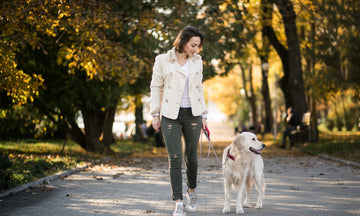Most pet owners are well aware of their pet’s preferences, food habits, and emotions, but understanding their vision is a different story. Humans and dogs see and perceive the world differently. As a dedicated pet owner, you must take time to understand your dog’s perspective. Let's explore in detail the canine vision and how your furry friend views the world.
What is a dog’s vision compared to a human’s?
Imagine a place bathed just in the shades of yellow and blue. That's a rough visual representation of how dogs perceive the world. While they can't distinguish between these colors, they can still see them, just not as distinctly as we do. Dogs view the whole world largely in shades of blue, yellow and grey. For example, colors like red, orange, and brown appear as different shades of yellow.
What you see V/s What your dog see
Let us understand the canine vision with more examples:-
Example 1
Red or Pink: For the human eye, the image appears in pink color (left) but it likely appears as a dark brown or grayish shade to your dog (right).
Example 2
Green or Orange: For the human eye, the image appears in green color (left) but it is often perceived as a dull yellow or tan by the dog (right)
Example 3
Blue or Purple: Easily recognized as shades of blue, making them stand out more clearly against natural landscapes like grass or dirt.
Example 4
Yellow: Dogs can easily recognise yellow color, as yellow appears as a bright and vibrant color
The science behind the vision difference
The number of cones determines the type and range of colors that we can perceive. We (humans) can perceive a wide range of colors as compared to dogs because humans are trichromats. Simply speaking, we have three types of cone cells in our eyes that allow us to view a wide spectrum of colors. While on the other hand, dogs are dichromats, meaning they possess only two types of cone cells. This limitation restricts their color perception to primarily blue and yellow.
While humans have more cones, allowing us to see all the colours of the rainbow in their brightest form, dogs have a higher amount of rods, which helps them to see things better in low light or identify moving objects at a faster pace than you. This is why your dog might get distracted by a bird flying 40 meters away that you didn’t even notice or will bark at night at a small animal that you’re unable to see!
Due to less number of cone cells in their retina, your dogs can not see the same band of colors that we can see nor can they see them as brightly and accurately as we do.
Common myths regarding Dog’s vision
MYTH: Dogs are color blind
MYTH DEBUNKED: No, the dogs are not color blind. Dogs do have limited vision and they can view a lesser number of colors but that does not mean that they are color blind. So if you are asking me “are dogs color blind”, the straightforward answer is no. Your pet can not differentiate colors largely. When a person is a red-green color blind, it means exactly that: they can’t discern between those two colors. The same is true for your dog. For example, red appears as a dark brownish-grey hue or even as black to a dog. Additionally, shades of yellow, orange, and green all appear as a type of yellowish shade to your canine friend
MYTH: Dogs can only see in black and white
MYTH DEBUNKED: Though dogs have limited visual and optical abilities but that doesn't translate to a black and white screen for them. Their eye frame can view everything in shades of blue, yellow and grey.
MYTH: All dogs have the same vision abilities.
MYTH DEBUNKED: No, not all the dogs have the same vision. In fact, different breeds have different eyesight or optical abilities based on their physical traits. For example:
- Sighthounds (e.g., Greyhounds, Whippets) have excellent distance vision and peripheral vision due to their elongated eyes.
- Breeds with short noses and rounder faces (e.g., Bulldogs, Pugs) may have a narrower field of vision and are more prone to eye problems.
MYTH: Dogs’ eyes glow because they see in the dark.
MYTH DEBUNKED: The glowing appearance of dogs' eyes at night is due to the tapetum lucidum, a reflective layer behind their retinas that enhances their ability to see in low-light conditions. While this adaptation improves night vision, it does not mean they see in complete darkness.
What colors do dogs see the best?
If I had to answer it simply, I would say blue and yellow. Puppies can differentiate these colors better while playing or training. Since, red, green and orange all appear as some shade of yellow, differentiating a red ball from green grass might be difficult for your dog. However, he will be able to discern the blue toy over the rest, which makes playing more fun for him!
How Does This Affect Dogs?
Though dogs’ color vision is limited compared to humans, their other senses make up for it. Dogs rely heavily on:
Motion Detection: Their eyes are highly attuned to movement, which is why they excel at spotting moving objects, even in low light.
Night Vision: Dogs’ retinas have more rod cells, enabling them to see well in dim lighting.
Peripheral Vision: Dogs generally have a wider field of vision than humans, depending on their breed.
Why Does It Matter?
As a pet owner, you can better understand and interact with your dog with better knowledge about the dog's vision impairments and limitations. Here are some practical ways in which you can create a better environment for your fluffy friend.
Choosing the best Toys:
Now that you know the best toys for them, you should buy toys of those colours. Don't just pick the toys that appears best to you, buy the toys that will make the playing more fun for both of you. Stick to toys that are primarily blue or yellow for better visibility.
Training and Cues:
When you engage in target training or cue training, make sure to use blue or yellow to make them differentiate certain orders or behaviors. For example, a red target might appear as a dull, indistinct object to your dog, making training with that color less effective. Consider using contrasting colors or textures for better results.
Enhancing Safety:
If you are playing outdoors with your dog, a brightly colored blue or yellow leash or collar might be easier for them to spot. This is particularly useful in low-light conditions when contrast becomes more important than color.
Understanding Behavior:
Since dogs rely on other senses more than vision, such as smell and hearing, it’s important to remember that your dog’s behavior in certain situations might not be due to their inability to see a specific color, but rather their focus on different environmental stimuli.
Other differences between human and dog’s vision
Think the way dogs see the world is astonishing? Wait until you hear this - it's about to get even more mind-blowing! Not only do humans and dogs differ in terms of their respective color spectrum, they also differ on other visual abilities. Some of these differences are mentioned below 👇
Field of Vision
Despite the color impairments, dogs can detect movement and threats more easily and are also considered expert watchdogs. How? It is because Dogs have a wider field of vision (270°) compared to humans (180°).
Motion Sensitivity
Rod cells which are sensitive to shape, movement, and light. And higher concentration of rod cells in dog's retina as compared to humans are more widely present in retina of dog than in human, make them incredibly adept at detecting movement. This makes them expert hunters and chasers.
Low-Light Vision
Dogs have better low-light vision than humans, courtesy of the reflective layer in the back of their eyes called the tapetum lucidum. This adaptation helps them navigate and hunt in dimly lit environments.
Depth Perception
Dogs have limited depth perception compared to humans, which can affect their ability to judge distances and spatial relationships.
Visual Processing
Dogs process visual information differently than humans. While we focus on details and patterns, dogs prioritize movement and changes in their environment.
By understanding these unique aspects of canine vision, you'll gain a deeper appreciation for how your dog experiences the world. This knowledge will help you tailor your interactions, training, and even your home environment to better suit your furry friend's visual needs.
What color is best for your dog’s favourite toy?
If you ask me for the best color for a dog’s toy, I am definitely suggesting blue. Blue is the best color as it stands out most for your dog. Your cute companion can easily distinguish blue color when compared with other colors.
This is why when playing a game of fetch with a ball, your dog might have a hard time telling the difference between a red or green ball on the green grass since it all looks the same to him. However, he will be able to discern the blue toy over the rest, which makes playing more fun!
So if you’re wondering which color of toy to buy your furry friend, choose blue and yellow toys over any other color. Not only will they enjoy it more but also they can differentiate these colors better from the background.
Grab a blue ball when headed outside so your dog is more likely to see the toy against the contrast of the green grass. If playing indoors, you can essentially choose any colour of toy that your dog can see – like blue, yellow, or purple.
FAQs
1. Are dogs color-blind?
Ans- No, the dogs are not at all color-blind. Instead, they have limited vision and a lower spectrum of colors is perceived by them. They perceive world in notions of blue, yellow and grey.
2. Can dogs see green?
Ans- Dogs can see green but it does not appear the same as it appears from the human vision. In their dichromatic vision, green appears as a dull yellow or tan. This is because dogs lack the red-sensitive cone found in human eyes, which is essential for distinguishing between red and green. As a result, colors like green and orange blend into similar hues, making it harder for dogs to differentiate between them.
3. Which color is best for a dog's favourite toy?
Ans- You should definitely buy blue or yellow colored toys to make your playtime fun for your dog too.
4. Can dogs see colors like humans?
Ans- No, dogs do not see colors the way humans do. Humans are trichromats which means they have three types of color receptors (cones) in their retina, allowing them to see a wide spectrum of colors. Whereas, dogs are dichromats meaning they have only two types of cones, so their visible color palette is more limited.






